Greece, Gold, The Death Of Paper Money And The Modern State
Commodities / Gold and Silver 2015 Apr 10, 2015 - 09:27 AM GMTBy: Darryl_R_Schoon
 The size and existence of the modern state is limited only by the ability to borrow money; an ability dependent on the continuing value of fiat paper money. That limit has now been reached. Greece is not just a country that overindulged on the bankers’ poisoned candy of cheap credit. Greece is the canary in the coal mine of the modern state.
The size and existence of the modern state is limited only by the ability to borrow money; an ability dependent on the continuing value of fiat paper money. That limit has now been reached. Greece is not just a country that overindulged on the bankers’ poisoned candy of cheap credit. Greece is the canary in the coal mine of the modern state.
When gold was removed from the international monetary system in 1971, US interest rates were 6%. By 1980, however, US rates rapidly rose to 21.5% in order to contain virulent inflationary forces unleashed when ties between paper money and gold were cut. The separation of gold and money was unprecedented. So, too, would be the consequences.
CROSSING THE RUBICON: FALLING INTEREST RATES, THE DESTRUCTION OF CAPITAL AND THE END OF FIAT PAPER MONEY
US interest rates have now fallen for 35 years. In the short term, falling interest rates are viewed as positive, growth is encouraged and investors leverage ever-cheaper credit to reap ever-larger rewards in ever-expanding markets.
In the long term, however, continually falling interest rates are a sign that something is fundamentally amiss; that the requisite balance between credit and debt necessary for self-sustaining growth is missing. Continually falling interest rates—like continually falling blood pressure—indicates the presence of a pathological monetary state that is ultimately fatal.
In his article, Euthanasia of the Pension Funds, (Part 1) Professor Antal E Fekete pointed out the dangers of continually falling interest rates:
…a falling interest-rate structure has a deleterious effect on accumulated capital. Capital is destroyed across the board simultaneously and stealthily. By the time the damage is discovered, it is too late to do anything about it and firms go bankrupt in droves. The falling trend of interest rates is the unrecognized cause of the depression that is presently devastating the world economy.
…The last vestiges of the gold standard were unilaterally discarded by the government of the United States in 1971. This event was coincident with the onset of the greatest gyration in the rate of interest on a world-wide scale. In a decade interest rates shot up to two-digit figures in the high teens. Then a slow decline started in the 1980's pushing interest rates relentlessly towards zero. The first move (rising interest rates) was accompanied with a great surge of inflation, wiping out a large part of the value of pension rights. The second move (falling interest rates), which is still continuing, has brought deflation. It has not yet fully manifested its corrosive on the pension funds as yet. Even so, the forces that drive the rate of interest to zero are squarely responsible for the erosion or destruction of all capital...
CONTINUALLY FALLING RATES AND EXCESSIVE MONETARY GROWTH
Below, I combined a chart of falling interest rates (greshams-law.com) with a chart of the US money supply (St. Louis Fed), further evidence of the destruction of capital.
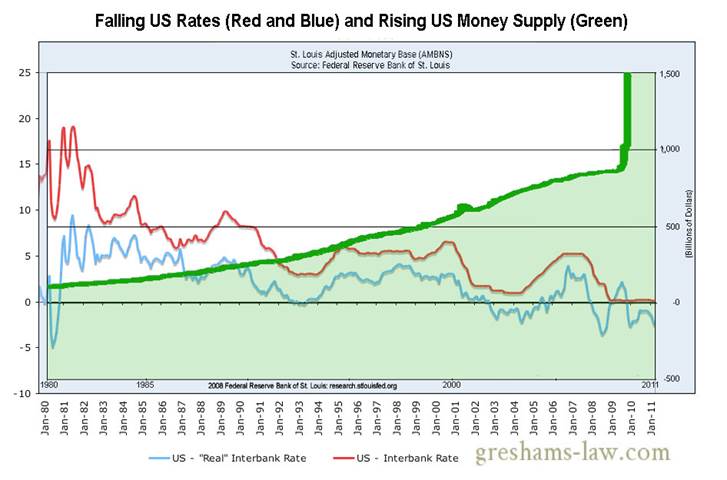
Because of the continuing increase in the money supply, the dollars of today are worth less than yesterday’s and those of tomorrow will be worth less than today’s. We are now, all of us, running faster and faster at unsustainable levels on a treadmill towards inevitable disaster.
pg. 64, Time of the Vulture: How to Survive the Crisis and Prosper in the Process, 3rd ed. (2012), Darryl Robert Schoon
THE TIME OF THE VULTURE
When the Roman empire collapsed, even slaves feared what would happen next. It is no different today.
In the 1st edition of my book, Time of the Vulture: How to Survive the Crisis and Prosper in the Process (2007), I predicted a financial crisis even more devastating than the Great Depression was about to happen.
Today’s devastation will be even greater, because paper money is no longer backed by gold. The coming deflationary depression will involve not just the collapse of capital markets but, in addition, a cataclysmic currency crisis caused by the global destabilization of money.
When stocks lose their value
That’s a terrible thing
When homes lose their value
That’s a terrible thing
But when money loses its value
That’s the most terrible thing of all
Time of the Vulture (1st ed. 2007)
When I published Time of the Vulture, Fed interest rates were 5 ¼ %. When the financial crisis began in 2008, the Fed slashed rates to almost zero, 0.0-0.25%, to provide markets with excessive levels of liquidity to offset the sudden and severe drop in global aggregate demand.
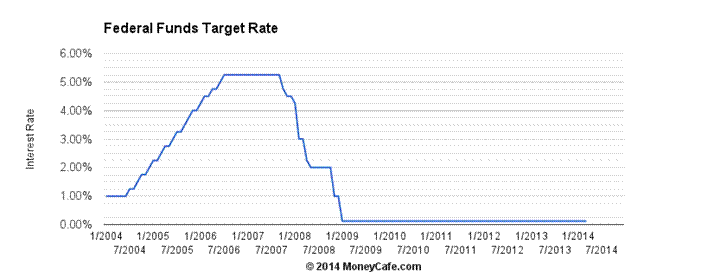
Today, 90% of industrialized economies now have interest rates near zero or below zero.
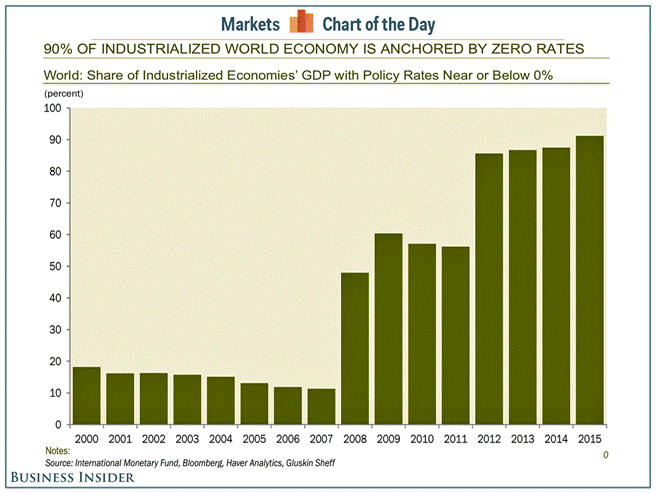
In addition to near zero interest rates, central banks created excessive amounts of money by issuing trillions of dollars of bonds, e.g. QE1, QE2, QE3, QE4, etc. pushing unprecedented amounts of newly created money into global markets to contain the growing deflationary threat; and, while it failed to contain deflation, the excessive liquidity is now circulating in markets with no place to go, akin to moribund monetary edema.
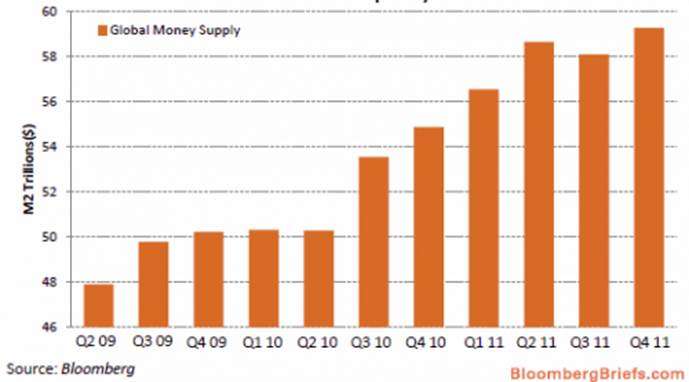
In capitalism’s end game, capital instead of circulating in the economy accumulates in financial markets. Bubbles are the result, not economic expansion; and, as aggregate demand fatally slows, so, too, does the velocity of money.
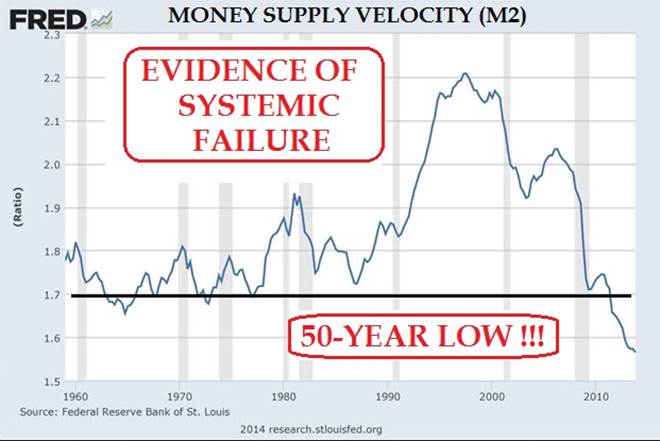
http://chartramblings.blogspot.com/2014_04_01_archive.html
Capitalism, like a bicycle, doesn’t do well at slow speeds
In the 1930s, when global demand collapsed, countries fought for shares of a shrinking market by levying tariffs on imported goods. The US Smoot-Hawley Tariff imposed surcharges on over 20,000 imported goods to record levels. Enacted to protect domestic markets from foreign imports, the net effect, however, was to accelerate the collapse of international trade.
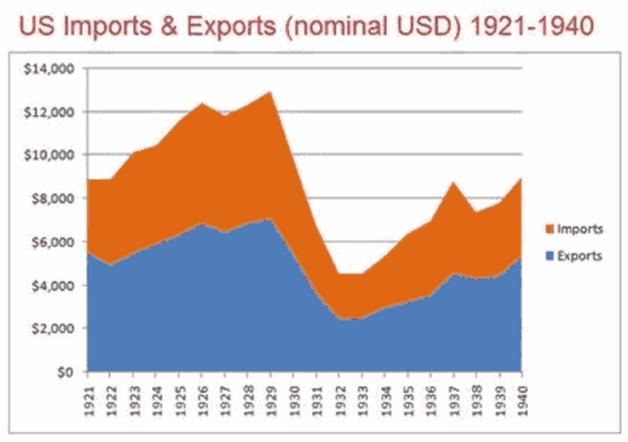
http://www.theautomaticearth.com/2010/07/the-rise-and-fall-of-trade/
As in 1929, international trade fell in 2009; but, this time, countries moved to protect markets not with tariffs but by debasing their currencies with excessive money printing, making their exports cheaper in foreign markets.
Debasing currencies to obtain a trade advantage, however, is akin to the Chinese proverb, Drinking poison to quench thirst, 飲鴆止渴. While the advantages are temporary, the consequences are not.
In November 2012, I wrote:
There are only two possibilities left in the bankers’ end game. Either deflation’s growing momentum will pull today’s faltering economies into the ever-growing maw of a deflationary collapse or the continued printing of money to stave off such a collapse will end with the complete debasement of paper currencies in a hyperinflationary blowoff.
Schoon, The Tipping Point (2012)
Today’s excessive money printing—whether to gain a trade advantage or to prevent a deflationary collapse—will end in the cataclysmic collapse of today’s fiat currencies and the consequent disarray of global markets and sovereign states.
GOLD BULLION - A LIFE INSURANCE POLICY ON FIAT PAPER MONEY
When paper money dies, the payout will be spectacular
GOLD IS VOLATILE WHEN CONDITIONS ARE VOLATILE
GOLD IS STABLE WHEN CONDITIONS ARE STABLE
That’s it, plain and simple. The more chaotic the monetary conditions, the more chaotic the price of gold. Gold is a barometer of economic uncertainty. In times when inflation threatens, gold moves up and down. In times when deflation threatens, gold moves up and down. When both inflation and deflation threaten, gold moves rapidly up and down.
Pg. 127, Time of the Vulture, 3rd. ed. 2012, Schoon
After 2001, gold moved upwards, from $250 to $1900 in 2011. Since 2011, gold has retraced 42 % of those gains. This had a negative effect on many gold investors. Indeed, that was the purpose of the bankers’ war on gold after 1971.
For those who understand the tremendous financial and geopolitical forces that today are vying not so much for supremacy as they were previously, but for survival; gold remains as it always has been—a store of value in times of monetary chaos and economic distress.
In March 2007, I predicted that an economic crisis would happen. It did. That crisis has yet to run its course to make way for the better world to come. In my Dollars & Sense youtube video, Darryl’s New Prediction, see https://youtu.be/qZJCTCO36DM. I make another forecast.
These are interesting times. Get used to it.
Buy gold, buy silver, have faith.By Darryl Robert Schoon
www.survivethecrisis.com
www.drschoon.com
blog www.posdev.net
About Darryl Robert Schoon
In college, I majored in political science with a focus on East Asia (B.A. University of California at Davis, 1966). My in-depth study of economics did not occur until much later.
In the 1990s, I became curious about the Great Depression and in the course of my study, I realized that most of my preconceptions about money and the economy were just that - preconceptions. I, like most others, did not really understand the nature of money and the economy. Now, I have some insights and answers about these critical matters.
In October 2005, Marshall Thurber, a close friend from law school convened The Positive Deviant Network (the PDN), a group of individuals whom Marshall believed to be "out-of-the-box" thinkers and I was asked to join. The PDN became a major catalyst in my writings on economic issues.
When I discovered others in the PDN shared my concerns about the US economy, I began writing down my thoughts. In March 2007 I presented my findings to the Positive Deviant Network in the form of an in-depth 148- page analysis, " How to Survive the Crisis and Prosper In The Process. "
The reception to my presentation, though controversial, generated a significant amount of interest; and in May 2007, "How To Survive The Crisis And Prosper In The Process" was made available at www.survivethecrisis.com and I began writing articles on economic issues.
The interest in the book and my writings has been gratifying. During its first two months, www.survivethecrisis.com was accessed by over 10,000 viewers from 93 countries. Clearly, we had struck a chord and www.drschoon.com , has been created to address this interest.
Darryl R Schoon Archive |
© 2005-2022 http://www.MarketOracle.co.uk - The Market Oracle is a FREE Daily Financial Markets Analysis & Forecasting online publication.



